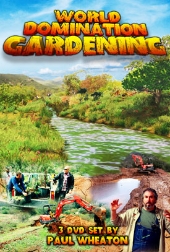Semi arid climate, typical hot drought summers, snowy wet winters. Best techniques of growing most food with minimal irrigation?
Hey y'all. I've got a site in central Washington, about 20" precip per year with most precipitation from October-March consisting of snow, which then melts and the weather turns very hot and dry throughout the summer, including high wildfire risks. The site has a slight slope down toward a creek about 400 feet away. I'm trying to grow fruit/nut/native trees/shrubs and staple vegetables like corn, potatoes, beans, and squash. High calorie foods. But, I want to do it with minimal irrigation, ideally none.
Question is, with this section of land, would you recommend one of the following:
a) rent an expensive excavator, gather tons of logs, and make giant hugelkulturs on contour
b) hand dig swales, fill them up to just about ground level with logs and brush, then cover with soil to act as natural berms, then plant into those with trees/shrubs
b) dig swales on contour, but plant things within the swales rather than on the berms because the climate is so dry and so sunken beds would actually be more beneficial
c) dig swales, plant trees on the downhill slopes of the swales, then with the 15 feet between the swales plant vegetable crops and bite the bullet and run drip irrigation to them
d) dig swales, plant trees on the downhill slopes of the swales, then run chicken/rabbit tractors between the swales until eventually the soil is so rich you can dry farm veggies in between the swales
e) rent expensive excavator, and without previous experience doing so although many hours spent reading and watching youtube videos on the subject, try to dig pond on south side of these hugelkulturs/swales/etc.
f) something else
Open to any and all ideas. Here's a drawing of the landscape. Extra info: I've water dowsed and got readings of potential water underground going through these dotted lines on the land. Previous land owner said they had two water dowsers out who both said there was a large underground spring in that southeastern line specifically. Haven't found much indicator plants for this yet, other than wild ancient apple tree along road that is one of few areas not previously mowed (i've only been here one year). Also, my drinking water is currently heavily filtered due to extreme iron amounts. Having a better source of water is of interest. IDEAS IDEAS IDEAS WHO'S GOT EM??





